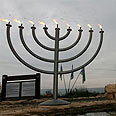
Zealotry or moderation?
Hanukkah good opportunity to examine contemporary Zionist identity
The Hanukkah holiday has been embraced by Zionism to a greater extent than any other holiday. The war of the Hasmoneans has been perceived as reflecting and anticipating the ongoing war for Jewish independence, while the Maccabees became a model for the Hebrew soldier. However, reviewing the views of our sages enables us to examine our contemporary Zionist identity vis-à-vis this holiday.
The first chapter of the Book of the Hasmoneans describes Antiochus’ letter, which orders all peoples to abandon their faiths. When an envoy arrives in order to apply this order in Modi’in, Matityahu refuses to follow the decree.
Next, “a Jewish man came, in the sight of all, to sacrifice on the altar…according to the king's command. And Matityahu saw this, and he was filled with zeal, and his reins trembled, and he cast forth his rage according to judgment, and he ran and slew him upon the altar. And also the king's commissioner…He was zealous for the Torah, as Pinchas had done towards Zimri, son of Salu.”
On the face of it, Matityahu did well, based on Jewish criteria. He was a man filled with national pride and he did not bow before the envoy who came to erase his Jewish identity. The writer of this passage also connects the act to that of Pinchas, the man who was blessed by God. Overall, Matityahu is presented as a model that cannot but be sympathized with.
However, those who read what our sages wrote realize that neither Matityahu nor Pinchas were their models. The sages are uncomfortable with the zealous demeanor displayed by Pinchas and Matityahu. They express their position, which objects to the image of the zealous man whose heart burns with fanaticism.
The kind of temperament admired by the sages was a moderate, stoic one. This demeanor is the opposite of Pinchas’ and Matityahu’s character.
A blend of both worlds?
Our sages could not uproot Hanukkah, which became a national holiday among the people. But let’s see how they shaped it: “The mitzvah of Hanukkah entails lighting one candle each night for a person and his household. Mehadrin (those who perform the mitzvah in a meticulous manner) light one candle each night for every member of the household. And what is the practice of the mehadrin min hamehadrin (those especially meticulous)? The School of Hillel maintains that on the first night, one candle should be lit, and each night the number should be increased... “
Had the sages’ basic position been accepted, we would light only one candle, which would blend in with the other light in the household; hence, the symbol of the holiday would not have been felt. Yet popular opinion did not accept this, and insisted on each household lighting the candles in the most meticulous manner. Even so, our sages insisted that the celebration not burst forth immediately, but rather, develop slowly and moderately with every passing day, until it reaches the eighth day.
The sages also ruled that the candles be placed outside, or on the window seal. This would mean that within the household there would be no sign of Hanukkah – the candles would be outside, while regular routine prevails inside. Yet here too popular opinion did not accept the sages’ view, and in most homes the candles are placed inside the household.
And so, the holiday has turned into a battlefield for contemporary Jewish identity in Israel. Who do we wish to be like – the temperamental and belligerent Matityahu and Pinchas, or the moderate and restrained sages? And perhaps, as is the case with constructive disagreements, we wish to see a blend of these two characteristics, creating an Israeli identity that contains both worlds?
Moshe Meir holds a PhD in Jewish Thought and leads Jewish study groups










